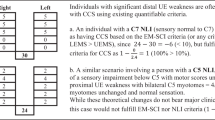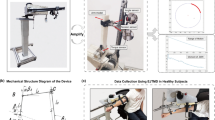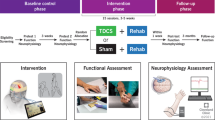Abstract
Study design:
Systematic review.
Background:
The applied definition of traumatic central cord syndrome (TCCS) lacks specific quantified diagnostic criteria.
Objective:
To review currently applied TCCS diagnostic criteria and quantitative data regarding the ‘disproportionate weakness’ between the upper and lower extremities described in original studies reporting on TCCS subjects.
Methods:
A MEDLINE (1966 to 2008) literature search was conducted. The descriptors applied to define TCCS were extracted from all included articles. We included original studies that reported on the differences in motor score (based on the Medical Research Council scale) between the total upper extremity motor score (UEMS) and the total lower extremity motor score (LEMS), in a minimum of five TCCS patients at the time of hospital admission. The mean difference between the total UEMS and the total LEMS of the patients included in each study was calculated. Case reports were excluded.
Results:
None of the identified studies on TCCS patients reported inclusion and/or exclusion criteria using a quantified difference between the UEMS and LEMS. Out of 30 retrieved studies, we identified seven different clinical descriptors that have been applied as TCCS diagnostic criteria. Nine studies reporting on a total of 312 TCCS patients were eligible for analysis. The mean total UEMS was 10.5 motor points lower than the mean total LEMS.
Conclusions:
There is no consensus on the diagnostic criteria for TCCS. Nevertheless, this review revealed an average of 10 motor points between the UEMS and LEMS as a possible TCCS diagnostic criterion. However, further discussion by an expert panel will be required to establish definitive diagnostic criteria.
Similar content being viewed by others
Log in or create a free account to read this content
Gain free access to this article, as well as selected content from this journal and more on nature.com
or
References
Schneider RC, Cherry G, Pantek H . The syndrome of acute central cervical spinal cord injury; with special reference to the mechanisms involved in hyperextension injuries of cervical spine. J Neurosurg 1954; 11: 546–577.
Bosch A, Stauffer ES, Nickel VL . Incomplete traumatic quadriplegia. A ten-year review. JAMA 1971; 216: 473–478.
McKinley W, Santos K, Meade M, Brooke K . Incidence and outcomes of spinal cord injury clinical syndromes. J Spinal Cord Med 2007; 30: 215–224.
Aito S, D'Andrea M, Werhagen L, Farsetti L, Cappelli S, Bandini B et al. Neurological and functional outcome in traumatic central cord syndrome. Spinal Cord 2007; 45: 292–297.
Dvorak MF, Fisher CG, Hoekema J, Boyd M, Noonan V, Wing PC et al. Factors predicting motor recovery and functional outcome after traumatic central cord syndrome: a long-term follow-up. Spine 2005; 30: 2303–2311.
Ishida Y, Tominaga T . Predictors of neurologic recovery in acute central cervical cord injury with only upper extremity impairment. Spine 2002; 27: 1652–1658.
Merriam WF, Taylor TK, Ruff SJ, McPhail MJ . A reappraisal of acute traumatic central cord syndrome. J Bone Joint Surg Br 1986; 68: 708–713.
Penrod LE, Hegde SK, Ditunno Jr JF . Age effect on prognosis for functional recovery in acute, traumatic central cord syndrome. Arch Phys Med Rehabil 1990; 71: 963–968.
Roth EJ, Lawler MH, Yarkony GM . Traumatic central cord syndrome: clinical features and functional outcomes. Arch Phys Med Rehabil 1990; 71: 18–23.
Tow AM, Kong KH . Central cord syndrome: functional outcome after rehabilitation. Spinal Cord 1998; 36: 156–160.
Parke WW . Correlative anatomy of cervical spondylotic myelopathy. Spine 1988; 13: 831–837.
Eidelberg E . Consequences of spinal cord lesions upon motor function, with special reference to locomotor activity. Prog Neurobiol 1981; 17: 185–202.
Levi AD, Tator CH, Bunge RP . Clinical syndromes associated with disproportionate weakness of the upper versus the lower extremities after cervical spinal cord injury. Neurosurgery 1996; 38: 179–183.
Quencer RM, Bunge RP, Egnor M, Green BA, Puckett W, Naidich TP et al. Acute traumatic central cord syndrome: MRI-pathological correlations. Neuroradiology 1992; 34: 85–94.
Collignon F, Martin D, Lenelle J, Stevenaert A . Acute traumatic central cord syndrome: magnetic resonance imaging and clinical observations. J Neurosurg 2002; 96: 29–33.
Guest J, Eleraky MA, Apostolides PJ, Dickman CA, Sonntag VK . Traumatic central cord syndrome: results of surgical management. J Neurosurg 2002; 97: 25–32.
Miranda P, Gomez P, Alday R . Acute traumatic central cord syndrome: analysis of clinical and radiological correlations. J Neurosurg Sci 2008; 52: 107–112.
Chen L, Yang H, Yang T, Xu Y, Bao Z, Tang T . Effectiveness of surgical treatment for traumatic central cord syndrome. J Neurosurg Spine 2009; 10: 3–8.
Saruhashi Y, Hukuda S, Katsuura A, Asajima S, Omura K . Clinical outcomes of cervical spinal cord injuries without radiographic evidence of trauma. Spinal Cord 1998; 36: 567–573.
Yamazaki T, Yanaka K, Fujita K, Kamezaki T, Uemura K, Nose T . Traumatic central cord syndrome: analysis of factors affecting the outcome. Surg Neurol 2005; 63: 95–99.
Newey ML, Sen PK, Fraser RD . The long-term outcome after central cord syndrome: a study of the natural history. J Bone Joint Surg Br 2000; 82: 851–855.
Noonan VK, Kopec JA, Zhang H, Dvorak MF . Impact of associated conditions resulting from spinal cord injury on health status and quality of life in people with traumatic central cord syndrome. Arch Phys Med Rehabil 2008; 89: 1074–1082.
Hayes KC, Hsieh JT, Wolfe DL, Potter PJ, Delaney GA . Classifying incomplete spinal cord injury syndromes: algorithms based on the International Standards for Neurological and Functional Classification of Spinal Cord Injury Patients. Arch Phys Med Rehabil 2000; 81: 644–652.
Chen TY, Lee ST, Lui TN, Wong CW, Yeh YS, Tzaan WC et al. Efficacy of surgical treatment in traumatic central cord syndrome. Surg Neurol 1997; 48: 435–440.
Song J, Mizuno J, Inoue T, Nakagawa H . Clinical evaluation of traumatic central cord syndrome: emphasis on clinical significance of prevertebral hyperintensity, cord compression, and intramedullary high-signal intensity on magnetic resonance imaging. Surg Neurol 2006; 65: 117–123.
Waters RL, Adkins RH, Sie IH, Yakura JS . Motor recovery following spinal cord injury associated with cervical spondylosis: a collaborative study. Spinal Cord 1996; 34: 711–715.
Bose B, Northrup BE, Osterholm JL, Cotler JM, Ditunno JF . Reanalysis of central cervical cord injury management. Neurosurgery 1984; 15: 367–372.
Brodkey JS, Miller Jr CF, Harmody RM . The syndrome of acute central cervical spinal cord injury revisited. Surg Neurol 1980; 14: 251–257.
Dai L, Jia L . Central cord injury complicating acute cervical disc herniation in trauma. Spine 2000; 25: 331–335.
Pollard ME, Apple DF . Factors associated with improved neurologic outcomes in patients with incomplete tetraplegia. Spine 2003; 28: 33–39.
Song J, Mizuno J, Nakagawa H, Inoue T . Surgery for acute subaxial traumatic central cord syndrome without fracture or dislocation. J Clin Neurosci 2005; 12: 438–443.
Uribe J, Green BA, Vanni S, Moza K, Guest JD, Levi AD . Acute traumatic central cord syndrome—experience using surgical decompression with open-door expansile cervical laminoplasty. Surg Neurol 2005; 63: 505–510.
Weingarden SI, Graham PM . Falls resulting in spinal cord injury: patterns and outcomes in an older population. Paraplegia 1989; 27: 423–427.
www.spinalcord.uab.edu. Facts and Figures at a Glance. National Spinal Cord Injury Statistical Center: Birmingham, Alabama. 2008.
Maynard Jr FM, Bracken MB, Creasey G, Ditunno Jr JF, Donovan WH, Ducker TB et al. International Standards for Neurological and Functional Classification of Spinal Cord Injury. American Spinal Injury Association. Spinal Cord 1997; 35: 266–274.
Hatzakis Jr MJ, Bryce N, Marino R . Cruciate paralysis, hypothesis for injury and recovery. Spinal Cord 2000; 38: 120–125.
Inamasu J, Hori S, Ohsuga F, Aikawa N . Selective paralysis of the upper extremities after odontoid fracture: acute central cord syndrome or cruciate paralysis? Clin Neurol Neurosurg 2001; 103: 238–241.
Bell HS . Paralysis of both arms from injury of the upper portion of the pyramidal decussation: “cruciate paralysis”. J Neurosurg 1970; 33: 376–380.
Ciappetta P, Salvati M, Raco A, Artico M . Cruciate hemiplegia: a clinical syndrome, a neuroanatomical controversy. Report of two cases and review of the literature. Surg Neurol 1990; 34: 43–47.
Kuitwaard K, Vandertop WP . A patient with an odontoid fracture and atrophy of the tongue: a case report and systematic review of the literature. Surg Neurol 2005; 64: 525–532 discussion.
van Middendorp JJ, Hosman AJ, Pouw MH, Van de MH . ASIA impairment scale conversion in traumatic SCI: is it related with the ability to walk? A descriptive comparison with functional ambulation outcome measures in 273 patients. Spinal Cord 2009; 47: 555–560.
Acknowledgements
This study was supported by the ‘Internationale Stiftung für Forschung in Paraplegie’ (IFP). We thank Mrs Alice Tillema (librarian) for her assistance in identifying eligible articles for this review.
Author information
Authors and Affiliations
Consortia
Corresponding author
Ethics declarations
Competing interests
The authors declare no conflict of interest.
Rights and permissions
About this article
Cite this article
Pouw, M., van Middendorp, J., van Kampen, A. et al. Diagnostic criteria of traumatic central cord syndrome. Part 1: A systematic review of clinical descriptors and scores. Spinal Cord 48, 652–656 (2010). https://doi.org/10.1038/sc.2009.155
Received:
Revised:
Accepted:
Published:
Issue date:
DOI: https://doi.org/10.1038/sc.2009.155
Keywords
This article is cited by
-
Central cord syndrome definitions, variations and limitations
Spinal Cord (2023)
-
Is it time to redefine or rename the term “Central Cord Syndrome”?
Spinal Cord (2021)
-
Recovery after traumatic thoracic- and lumbar spinal cord injury: the neurological level of injury matters
Spinal Cord (2020)
-
Degenerative cervical myelopathy — update and future directions
Nature Reviews Neurology (2020)
-
The case for revisiting central cord syndrome
Spinal Cord (2020)



